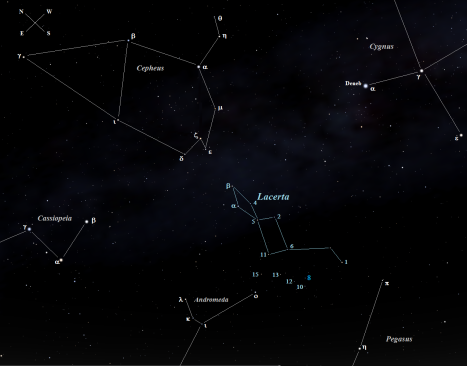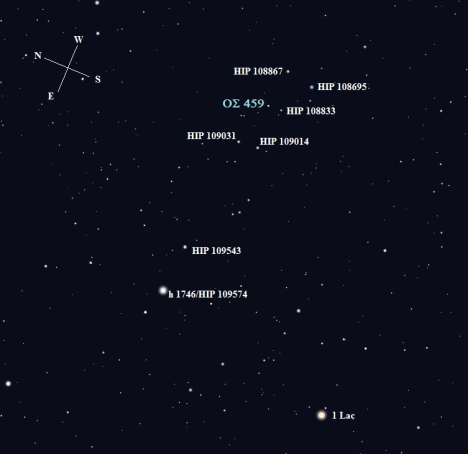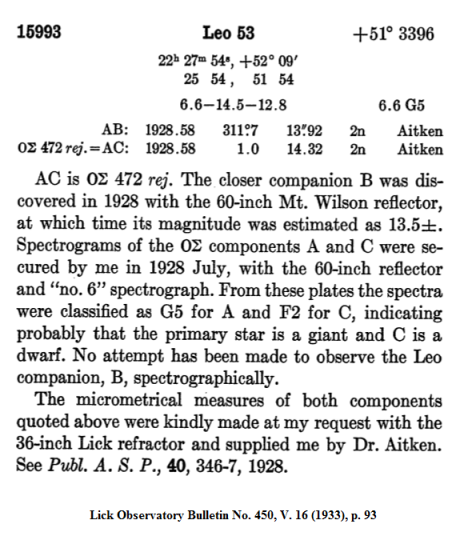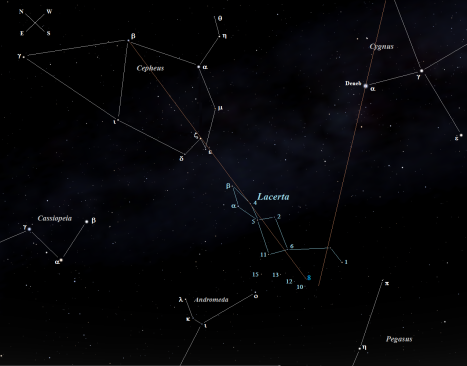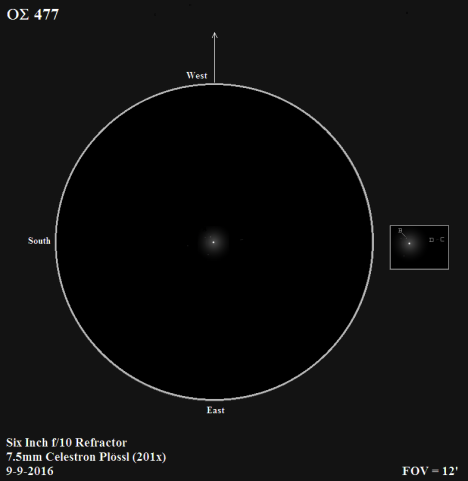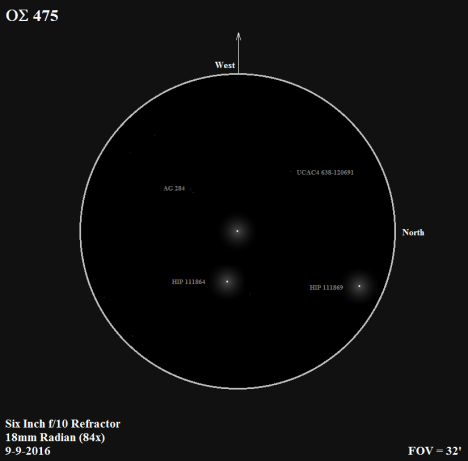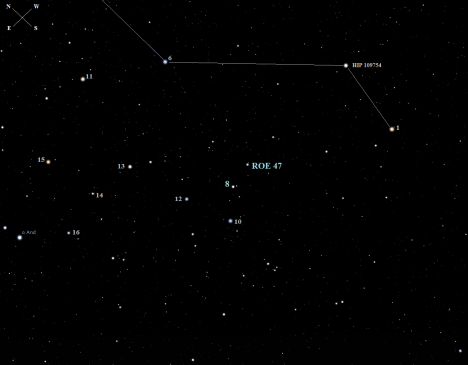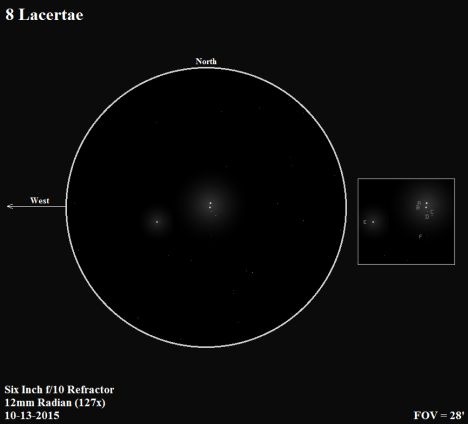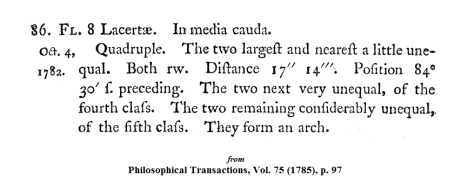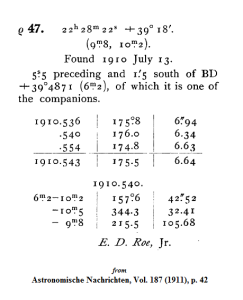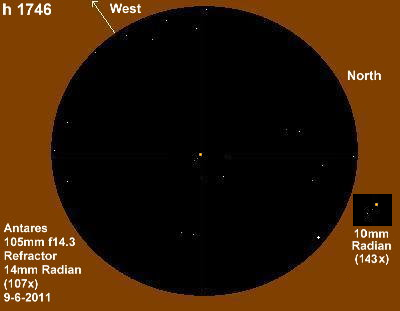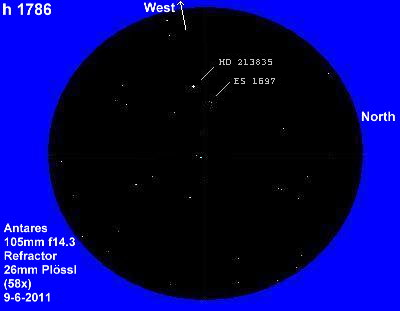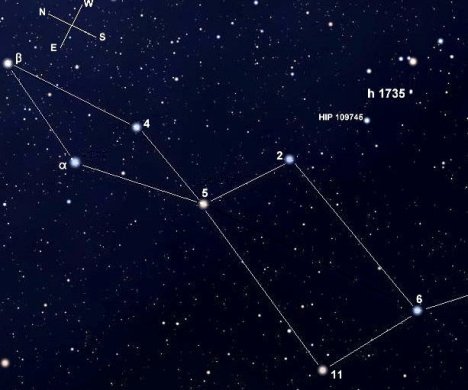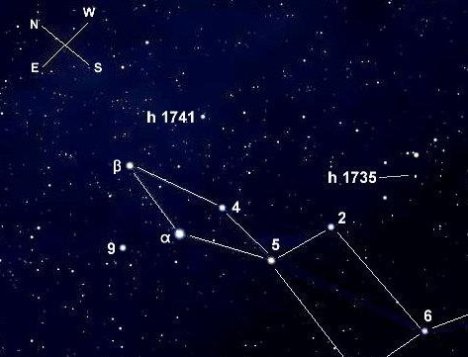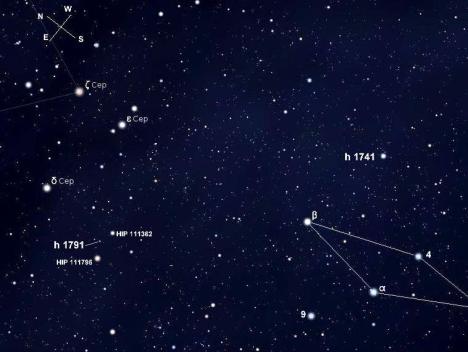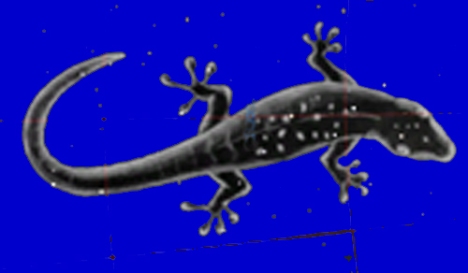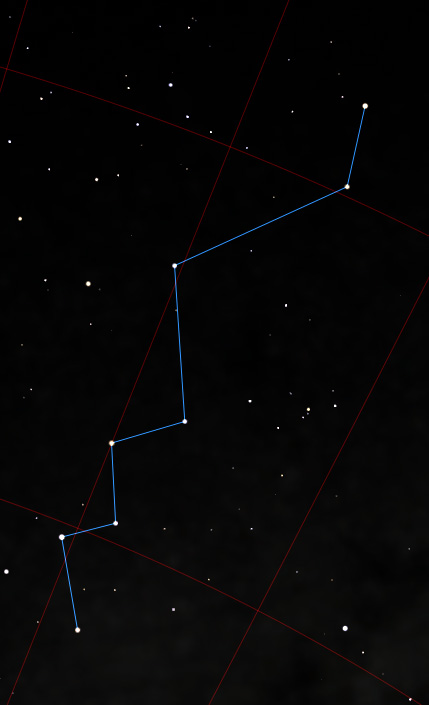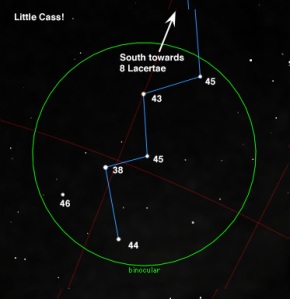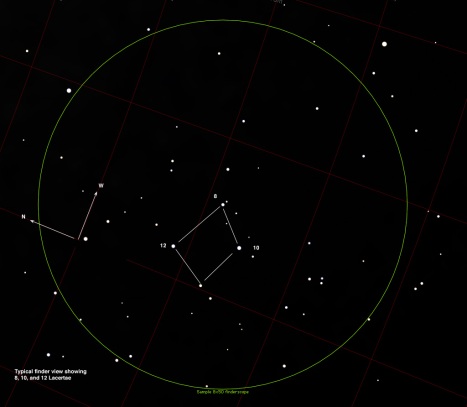On to the second part of a look at some STT objects in Lacerta. In case you missed the first part, you can get to it by clicking on this link.
We’ll get started with OΣ 459 (STT 459), which is located in the southern sector of the Lacertan lizard.
We’re going to start at 4.15 magnitude 1 Lacertae, which is located at the south tip of the constellation, and then follow the constellation diagram line that leads toward the north. That line comes to a halt at another similarly bright star with a magnitude of 4.50 which surprisingly has no commonly used identification other than h 1746 (HJ 1746), a pleasing double star I covered a few years ago in this post. But at the moment we’re going to use it as a jumping off point to reach OΣ 459. Here’s our chart:
Starting at h 1746, move west 30’ to 7.25 magnitude HIP 109543 and then continue west a full degree to reach 7.67 magnitude HIP 109014, which is paired with 7.73 magnitude HIP 109031 to the north. From that last star, a 25’ hop due west will land you on OΣ 459, which is shadowed to its south by 8.43 magnitude HIP 108833. For reference, there’s another dim pair of stars another 25’ further west, 7.65 magnitude HIP 108867 and 7.11 magnitude HIP 108695.
OΣ 459 (STT 459) HIP: 108841 SAO: 71981
RA: 22h 02.9m Dec: +39° 34’
Magnitudes: 8.2, 10.8
Separation: 10.6”
Position Angle: 196° (WDS 2010)
Distance: 1884 Light Years (GAIA)
Spectral Classification: A is A0
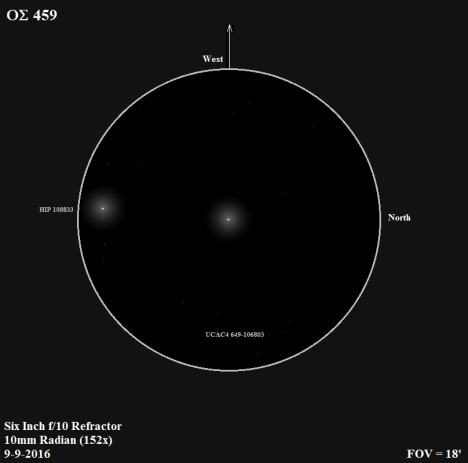
The white glow of OΣ 459 and its companion is at the center of this sketch, with one of our navigational stars, HIP 108833 parked at the south edge of the field of view (left in this sketch). North and south are reversed in this refractor view, click to get a better look.
With a difference of 2.6 magnitudes and a decently wide separation of 10.7”, this is not a difficult pair to split. I spied the secondary quickly with an 18mm Radian (84x) in my six inch refractor, but increased the magnification to 152x with a 10mm Radian in order to provide a more pleasing frame for the image. My search for a star of similar brightness to the OΣ 459 secondary eventually landed on UCAC4 649-106803, which has a UCAC4 Vmag (visual magnitude) of 11.150, so it appears the WDS value of 10.8 for the secondary is about right.
This pair was discovered by Otto Struve in 1845. He took two measures at that time, coming up with separations of 10.51” and 10.80”, and position angles of 197.8 and 196.5 degrees (p. 182 of this source). Compared with the most recent WDS measure of 2010, there’s been virtually no change in this pair, which is not surprising given its distance of 1884 light years.
Our next move is to a considerably more complicated star, OΣ 465. To get there we first need to head north to 4.44 magnitude Beta (β) Lacertae, which is located at the north tip of the Lacertan diamond (here’s the wide view again to get you headed in the right direction).
From Beta (β) Lacertae, which is located at the lower left center of the chart, it’s a two degree southwest leap (2° 9’ to be precise) to OΣ 465 (STT 465). You’ll find it 38’ south and slightly east of 5.38 magnitude HIP 109521, which is the first star you’ll come to on the southwest leap that’s similar in brightness to Beta (β) Lacertae. HIP 109521 is also known as h 1741 (HJ 1741), which is another double star we’ve looked previously and is in the same post referred to in the second paragraph above. As you scan the OΣ 465 chart, notice that 4.58 magnitude 4 Lacertae and 4.44 magnitude Beta (β) Lacertae from a triangle with STT 465 at the western tip, which should help to make sure you’re in the right place.
OΣ (STT 465) HIP: 109586 SAO: 51749
RA: 22h 12.0m Dec: +50° 12’
Magnitudes AB: 7.30, 10.55 AC: 7.30, 13.30
Separation AB: 12.80” AC: 17.80”
Position Angle AB: 317° (WDS 2010) AC: 233° (WDS 2003)
Distance: 2118 Light Years (Simbad), 4025 Light Years (GAIA)
Spectral Classification: A is F0

You’ll need to enlarge this sketch by clicking on it in order to catch glimpses of the B and C components. This is a rather close approximation of the visual difficulty I experienced while trying to pry the two faint companions loose from the primarial glare. We’re dealing with a wider range of magnitudes here than we did on the previous star, so be prepared to strain your visual receptors just a bit. (North and south reversed again to match the refractor view).
I’ve paid three visits to this triple star and each time was able to catch B pretty quickly in my six inch refractor with averted vision, hovering at the edge of the glare from the primary, but I needed 152x to do it. With a bit more concentration I even managed to capture it visually with direct vision for short periods.
My search for comparison stars landed on the two UCAC4 stars identified in the sketch to the west of the primary (above it in the sketch). Trying to keep B in view, whether with direct vision, or especially with averted vision, while comparing it to a similarly faint star is just a bit challenging to say the least, and can be a dubious process, as you’re about to see. I finally decided B is about midway between the two UCAC4 stars in brightness.
UCAC4 701-104020 has a UCAC4 Vmag of 11.518 and UCAC4 702-100946 a Vmag of 12.589, which would make B about 12th magnitude, or 1.5 magnitudes fainter than the WDS value, which really seems unlikely because B didn’t impress me as being a full magnitude fainter than UCAC4 701-104020. So it looks as though the 12.589 Vmag value for UCAC4 702-100946 may be an error. Adding to my doubts that B is 1.5 magnitudes fainter that the WDS value is the 10.546 UCAC4 Vmag for B. We never got around to measuring the magnitude of B, so I’m tempted to say the WDS value for B is probably about right, especially considering the experience I’m about to describe with the C companion.
That one was a real chore, but I managed to latch onto it a couple of times. If the 13.30 WDS magnitude is correct, there’s no way I would have seen it in my six inch refractor. More than likely it’s in the 12.7 to 12.8 range, which would be about at the limit of what I can glimpse in that scope while trying to see around the edges of the seventh magnitude glow of the primary. UCAC4 702-100946, with it’s supposed Vmag of 12.589, was nowhere as difficult to see, which is another reason I have doubts about the accuracy of that magnitude.
At any rate, comparing stars as faint as these, especially when some of them are imbedded in the glare of a primary, in order to arrive at a magnitude estimate can sometimes produce more questions than answers. It’s no wonder I found myself muttering in the damp darkness about the fickleness of faint stellar magnitudes while fighting off visions of a comfortable seat beside a warm fire with a good book and a hot cup of tea.
I don’t know how damp the darkness was when Otto Struve measured the B component in 1848, but according to Hussey’s account (p.191) he came up with separations of 15.26” and 15.38” and position angles of 324.1 and 324.6 degrees, which is notably different from the 2010 WDS numbers of 12.8” and 317 degrees.
There seems to be something fickle here, too, so let’s begin by looking at the two distances I’ve listed on the last line of the data above for OΣ 465. You’ll notice there’s a huge difference between the Simbad and the GAIA distances, but even if you go with the closest distance of the two, the primary of OΣ 465 is too far away to display any significant proper motion in the 162 years between Otto Struve’s 1848 measure and the 2010 WDS measure. I looked at some archived copies of the WDS and found there’s a consistent change in the separation and position angle of the AB pair, which is shown just above at the right. That list shows the average of Otto Struve’s two 1848 measures, as well as 1867 and 1898 measures by Dembowski and Hussey, respectively, which come from p. 191 of Hussey’s book. It’s quite possible B is a foreground star and is slowly moving in front of the primary, which would make this an optical pair and account for the steady change in separation and position angle. GAIA doesn’t have any parallax data yet on B, so without that crucial piece of information, there’s no way to be certain at this point where it lies in relation to the primary.
As for who added C, it took some digging, but persistence paid off. The WDS shows the first measure of the AC pair was made in 1908, which is a strong hint that S.W. Burnham was involved. However, I had no luck in finding it in his 1913 Proper Motion Catalog, which is the only catalog he published after 1908. So I turned to R.G. Aitken’s 1932 New General Catalogue of Double Stars Within 120° of the North Pole and tracked down OΣ 465 on page 1364 of the second volume. And sure enough, the catalog entry identified Burnham as the source of the first measure, including the actual numbers, which match the WDS data. And unlike the AB pair, those numbers are pretty close to the 2003 measures in the WDS, which again points to B as the half of the AB pair responsible for their gradual change.
On to our last STT object in this trip through Lacerta. You’ll find OΣ 472 one degree almost due east of Beta (β) Lacertae, and you’ll skirt past the very small open cluster NGC 7296 on the way. Here’s our previous chart once again.
OΣ 472 (STT 472) HIP: 111058 SAO: 34519
RA: 22h 29.9m Dec: +52° 25’
Magnitudes AB: 6.63, 11.50 AC: 6.63, 12.60
Separation AB: 12.90” AC: 12.50”
Position Angle AB: 300° (WDS 2013) AC: 356° (WDS 2013)
Distance: 404 Light Years (Simbad, no data in GAIA).
Spectral Classification: A is G8
Note: AB is LEO 53, AC is STT 472
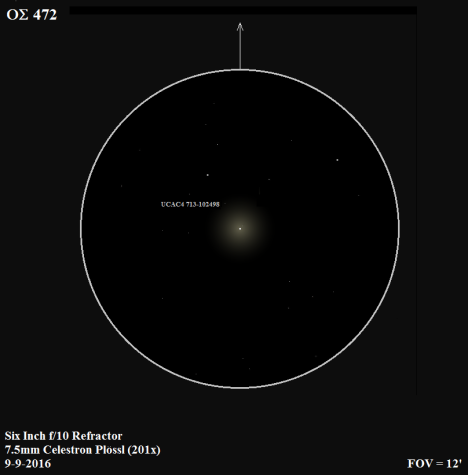
Again, you’ll have to enlarge this sketch by clicking on it and then looking closely at the one o’clock position to see a small speck of light. That’s the C component, the one discovered by Otto Struve. North and south reversed once more to match the refractor image.
I’ve looked at this triple star twice, about a year apart, and had no luck whatever at spying the B component. C wasn’t easy either, but with persistent averted vision and parallax-induced patience I managed to to pry it out of the primarial glare both times. I found it was very similar in magnitude to UCAC4 713-102498, which has a UCAC4 Vmag of 12.288. So it’s possible the C component is slightly brighter than the WDS value of 12.50.
On the other hand, the B component, located at virtually the same distance as C, is pretty clearly considerably fainter than the WDS value of 11.50. The only photometric data available on B is a UCAC4 f.mag of 13.924, which is a definite hint that B is somewhere in the 13.5 magnitude range.
The AC pair first appeared in Otto Struve’s 1845 catalog with an estimated separation of 15” and no position angle (see excerpt at right). The first published measure of the pair was made by Baron Dembowski in 1867, 15.80” and 365.8 degrees (p.192 of Hussey). OΣ 472 was later rejected in the second edition of the Pulkovo catalog because it was decided the separation of the pair exceeded the catalog limit of 16”, so apparently there was a measure made between 1843 and 1867.
As for the ear-catching LEO 53 (no association with Leo the Lion of constellation fame), it was pried out of the primary’s radiant glare in 1928 by Frederick C. Leonard, using the 60-inch reflector on Mt. Wilson. However, at Leonard’s request the actual measures were made by Aitken using the 36 inch Lick refractor. Leonard made a total of 56 double stars discoveries between 1917 and 1943. Because his published record of LEO 53 goes into more detail than is usual for a new double star measure, I thought it would be worth while to include it below in its entirety (source). Notice that Leonard estimated the magnitude of B to be ±13.5 at the time of discovery.
That wraps up Lacerta for now, but we’re not yet done with Otto Struve who will be back shortly to take us on a tour of four of his discoveries in Cepheus.
Clear skies and tolerable temperature! 😎
Filed under: 4. Choose a Constellation:, Lacerta | Leave a comment »


